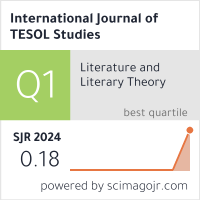2632-6779 (Print)
2633-6898 (Online)


Scopus
Ulrich’s Periodicals Directory (ProQuest)
MLA International Bibliography
MLA Directory of Periodicals
Directory of Open Access Journals (DOAJ)
QOAM (Quality Open Access Market)
British National Bibliography
WAC Clearinghouse Journal Listings
EBSCO Education
ICI Journals Master List
ERIH PLUS
CNKI Scholar
Gale-Cengage
WorldCat
Crossref
Baidu Scholar
British Library
J-Gate
ROAD
BASE
Publons
Google Scholar
Semantic Scholar
ORE Directory
TIRF
China National Center for Philosophy and Social Sciences Documentation
Miaomiao Sun
Baoji University of Arts and Sciences, China
Abstract
This study examines five Chinese EFL learners in a language institution regarding the effects of collocation noticing instructions in reading classes in terms of collocation competence and attitudes towards the noticing instructions. The data were collected from multiple sources, including vocabulary tests, pre/post collocation tests, in-class practice tests, questionnaire surveys, and semi-structured interviews. The analysis mainly focuses on two aspects: (1) the effectiveness of incorporating collocation learning into reading lessons, and (2) the learners' perception and attitude towards collocation noticing instructions. Data analysis shows that the reading intervention effectively raised learners’ collocation awareness, and that learners showed mixed attitudes towards it. They deemed useful the collocation orientation and input-enhancement approaches, especially the one with Chinese glossary embedded into reading texts, but they found self-directed noticing challenging and meanwhile realized that collocations learned in reading are difficult to output in writing and speaking. Therefore, this research suggests that language teachers should integrate collocation teaching into the classroom as early as possible through various awareness-raising methods, so that the input and output of collocation learning are not separated.
Keywords
Collocation, noticing, reading, input enhancement